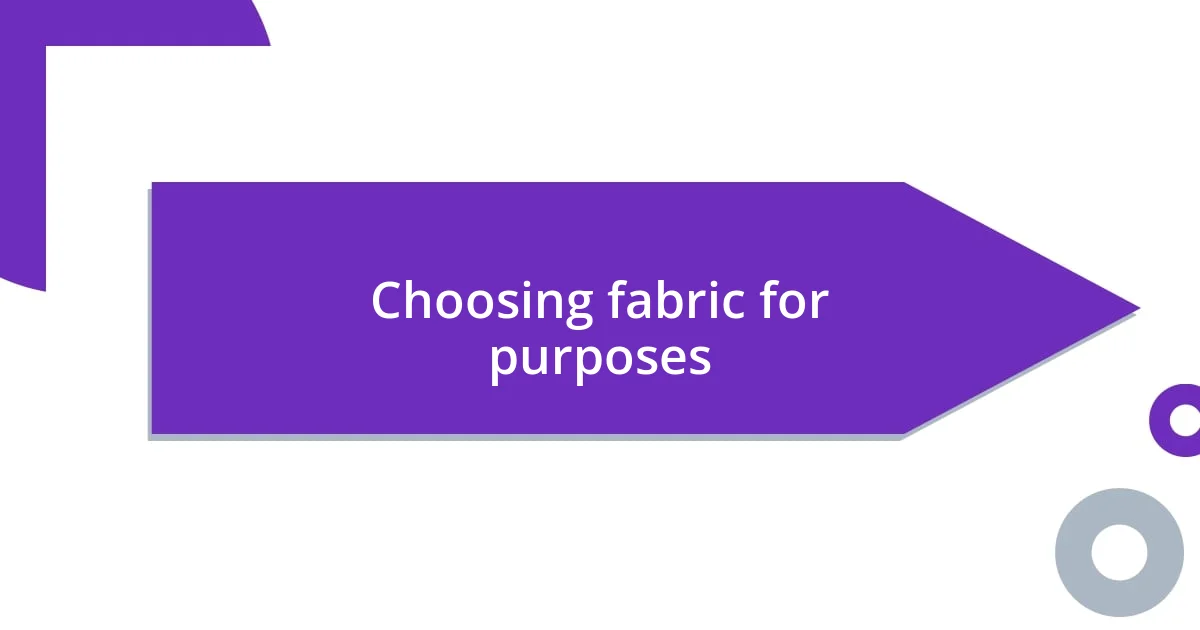Key takeaways:
- Understanding how fabric types influence comfort, mood, and emotional connections can enhance our daily experiences with clothing and decor.
- Evaluating fabric quality involves assessing weight, finish, stitching, fiber content, and care instructions to ensure durability and satisfaction over time.
- Caring for specific fabrics according to their needs prevents damage and prolongs their life, highlighting the importance of mindful maintenance in fabric selection.

Understanding fabric types
When it comes to understanding fabric types, it’s all about recognizing how each material interacts with our bodies and emotions. For instance, I distinctly remember selecting a soft bamboo blend to make a cozy throw blanket. The instant I wrapped it around myself, I felt a wave of comfort that reminded me of my grandmother’s embrace. Isn’t it fascinating how the right fabric can evoke such warm feelings?
Different fabric types not only vary in texture but also in their functionality and impact on our everyday lives. I find cotton to be an indispensable choice for casual wear; it breathes easily and feels great against the skin, particularly in the sweltering summer heat. Have you ever noticed how wearing certain fabrics can boost your mood on a busy day? For me, slipping into a comfortable cotton tee instantly enhances my energy.
As we delve deeper into fabric types, consider the environmental impact as well. When I switched to organic linen for my home decor, not only did I appreciate its elegance, but I also felt proud knowing it was a more sustainable choice. This decision sparks a valid question: are we choosing fabrics that align with our values? It’s a small change, but it can make a significant difference in how we feel about our choices in the long run.

Evaluating fabric quality
Evaluating fabric quality is essential when you’re selecting materials for any project. I remember a time when I splurged on what I thought was a luxurious silk blend for a dress. At first, it felt fantastic against my skin, but after just one wash, it lost its softness and sheen. That experience taught me the importance of not just looking for a label but understanding how fabric behaves over time under different conditions.
Here are some key factors to consider when evaluating fabric quality:
- Weight: Heavier fabrics often signal durability; lightweight fabrics are ideal for layering.
- Finish: Pay attention to how smooth or textured the fabric feels—this can indicate quality.
- Stitching: Look for consistent stitching and edges; fraying or uneven seams are red flags.
- Fiber content: Understand whether the fabric is natural or synthetic, as this affects comfort and longevity.
- Care instructions: Fabrics that require special care might indicate higher quality but could also be less practical for everyday use.
By considering these aspects, you’re more likely to choose fabrics that not only look good but also stand the test of time in your wardrobe or home.

Considering fabric weight
Considering fabric weight is crucial in determining how a garment or project will perform and feel. I discovered this firsthand while sewing a summer dress. Initially, I selected a lightweight chiffon, thinking it would be perfect for the warmer weather, but once I wore it, I found it clung awkwardly to my skin and provided no shape. It was an enlightening moment that taught me how fabric weight influences not just comfort but also the silhouette of a piece.
When evaluating fabric weight, it’s important to consider the intended use. For instance, heavier fabrics like canvas or denim are fantastic for durable items, such as bags or jackets. In contrast, lightweight fabrics like voile or georgette are excellent for airy blouses or summery skirts. I’ve often asked myself, how will this fabric feel throughout the day? Because, let’s be honest, the last thing anyone wants is to feel weighed down by their clothing on a hot day.
Here’s a quick comparison of different fabric weights and their typical uses:
| Fabric Weight | Typical Uses |
|---|---|
| Lightweight (<3 oz/yard) | Airy blouses, summer dresses, linings |
| Medium weight (3-6 oz/yard) | T-shirts, lightweight jackets, casual wear |
| Heavyweight (>6 oz/yard) | Outerwear, jeans, upholstery |

Exploring fabric textures
Exploring fabric textures is where the true character of a material shines through. I vividly remember the first time I felt a true linen fabric; it was a breath of fresh air. The texture was crisp yet soft, offering a unique combination that felt incredibly inviting against my skin. It made me realize how the tactile quality of fabric can evoke emotions and enhance overall comfort.
When I think about textures, I often gravitate towards natural fibers like cotton and wool. There’s something undeniably appealing about the plush feel of a cashmere sweater on a chilly day. Those soft, tactile experiences can completely transform how I feel about a garment. Have you ever slipped into something that just felt right? That’s the magic of fabric textures; they tell a story that goes beyond color or pattern.
On the other hand, synthetic fabrics can sometimes have surprising textures too. I once chose a polyester blend for a formal dress, expecting it to be rigid and uncomfortable. To my delight, the fabric had a smooth, almost velvety texture that made me feel elegant while allowing me to move freely. This experience reinforced my belief that exploring the textures of fabrics is not just about aesthetics—it’s about finding comfort and confidence in what we wear.

Analyzing fabric durability
When I dive into analyzing fabric durability, I cannot help but reflect on my first pair of jeans. They were made from a sturdy twill weave, and over the years, they withstand countless adventures. I often ask myself, what makes certain fabrics more resistant to wear and tear? My experience has taught me to look at the fiber content and construction. For instance, fabrics like denim and canvas typically boast high durability due to their dense, tightly woven nature.
I also consider the finish of the fabric. A water-repellent treatment can add not just to durability but to the longevity of a fabric, especially for outdoor wear. I remember a rain jacket I purchased that featured a durable water repellent (DWR) coating. It not only kept me dry during downpours but also maintained its strength against the elements. Isn’t it fascinating how a protective layer can significantly extend the life of fabric?
Finally, frequent washing and exposure to sunlight can really take a toll, leading me to consider care instructions seriously. I once learned this the hard way with a beloved cotton shirt that faded after too many washes under the sun. I now always check labels for washing recommendations, reminding myself that maintaining the integrity of the fabric is key to ensuring its durability. Thinking about fabric durability reminds me that it’s not just about how it looks, but how it performs over time.

Choosing fabric for purposes
Choosing fabric for specific purposes has always been an essential step for me, one that goes beyond just aesthetics. For instance, when I’m making something for warmer weather, I often lean towards lightweight cottons or linens. I remember sewing a sundress from a breathable cotton that not only kept me comfortable but also made me feel vibrant and free. How wonderful is it to wear something that feels just right for the occasion?
Conversely, when it comes to winter wear, my go-to fabrics are usually thicker knits or wool blends. I distinctly recall crafting a cozy blanket from a soft, chunky yarn that enveloped me in warmth during chilly nights. Whenever I snuggle up in it, I can’t help but smile—there’s something about the weight of a well-chosen fabric that enhances the experience. Have you ever wrapped yourself in a fabric that just feels like a hug? It’s those thoughtful fabric choices that truly elevate our experiences.
I also pay attention to the intended use of the fabric. For example, working on a project for kids means prioritizing durability and washability—I’d choose something like a sturdy cotton canvas that can withstand adventures and messes. I remember sewing a play mat for my niece, and the vibrant print combined with that tough fabric meant it survived spilled juice and countless playdates. Isn’t it rewarding when your fabric choice not only suits the purpose but also stands the test of real life?

Caring for different fabrics
Caring for different fabrics is an important part of my crafting journey. For example, I’ve learned that silk requires a gentle touch, often a hand wash or dry cleaning. I remember the first silk scarf I purchased—it was a stunning piece that I treasured but mistakenly threw into the washing machine. The agitation completely ruined its delicate pattern! Now, I treat silk with the respect it deserves, and I encourage others to do the same. Have you ever felt the heartbreak of a fabric mishap?
Then there’s the care for cotton, which I’ve come to appreciate for its versatility. While cotton can usually handle a regular wash, I make it a habit to sort colors to prevent unwanted bleeding. I distinctly recall a vibrant blue shirt that turned a sad shade of pink after a wash with my red towel. I still wear it, but it’s a reminder that a little caution goes a long way. What are some of your fabric care lessons learned the hard way?
Lastly, caring for synthetic fabrics is another area where I’ve gained insight. While they often claim to be low-maintenance, I’ve discovered they can also be prone to pilling and static cling. I remember wearing a cozy fleece jacket that felt amazing but started to look unkempt after just a few washes. To prolong its life, I now clean synthetics using a gentle cycle and avoid dryer heat whenever possible. Isn’t it satisfying to see your favorite pieces last longer with just a bit of mindful care?












